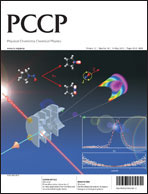In a systematic study, the influence of different preparation parameters on phase composition and size of metal crystallites and particles in Pd–Cu/TiO2 and Pd–Sb/TiO2 catalyst materials has been explored. Temperature and atmosphere of thermal pretreatment (pure He or 10% H2/He), nature of metal precursors (chlorides, nitrates or acetates) as well as of ammonium additives (ammonium sulfate, nitrate, carbonate) and urea were varied with the aim of tailoring the synthesis procedure for the preferential formation of metal particles with similar size and structure as observed recently in active catalysts after long-term equilibration under catalytic reaction conditions in acetoxylation of toluene to benzylacetate. Among the metal precursors and additives, the chloride metal precursors and (NH4)2SO4 were most suitable. Upon thermal pretreatment of Pd–Sb or Pd–Cu precursors, chloroamine complexes of Pd and Cu are formed, which decompose above 220 °C to metallic phases independent of the atmosphere. In He, metallic Pd particles were formed with both the co-components. In H2/He flow, Pd–Cu precursors were converted to core–shell particles with a Cu shell and a Pd core, while Sb1Pd1 and Sb7Pd20 alloy phases were formed in the presence of Sb. Metal crystallites of about 40 nm agglomerate to particles of up to 150 nm in He and to even larger size in H2/He.

You have access to this article
 Please wait while we load your content...
Something went wrong. Try again?
Please wait while we load your content...
Something went wrong. Try again?


 Please wait while we load your content...
Please wait while we load your content...